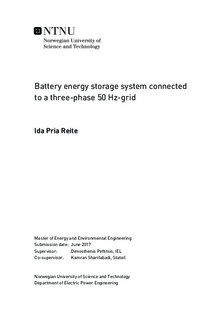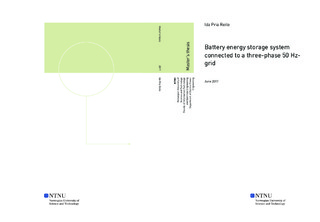| dc.description.abstract | Battery energy storage systems (BESS) employing secondary battery technology may
offer the greatest potential for large-scale integration of renewable energy sources (RES), and is considered a key element for enabling smart grids for future power systems. The two main components of a BESS are the power conversion system (PCS) and the battery management system (BMS). When selecting a PCS topology, the most important characteristic are the reliability and efficiency of the converter. The converter technologies commonly used for PCS have been the conventional two- and three-level voltage source converters (VSCs), however the PCS topology chosen for the BESS in this thesis is the modular multilevel converter (MMC).
The MMC offers several advantages over the conventional VSCs, such as modularity and scalability, low total harmonic distortion (THD), excellent efficiency and reliability. The battery technology chosen for the BESS is based on the lithium-ion battery technology. Lithium-ion offers desirable characteristics such as high efficiency, good response time, reasonably high charge and discharge rates, small dimensions and/or low weight and little maintenance requirements. All of the abovementioned converter and battery characteristics imply that the full MMC-BESS scheme will become highly efficient and reliable with a high round trip efficiency, well-suited for large-scale BESS applications.
The system in which the MMC-BESS is investigated, comprises of an offshore wind farm, a two-level VSC-based HVDC transmission system and the AC grid on land. Based on the investigated cases, this thesis can be divided into two main parts: design of the MMC-BESS, and modeling and simulation of the MMC-BESS. The design-part is mainly focusing on a more realistic approach of the MMC-BESS configuration by performing various calculations regarding both battery and converter requirements. The initial MMC-BESS configuration was the conventional, half-bridge MMC with centralized batteries connected to the common DC-link. This approach may offer the simplest solution to implement, however it negatively affects the reliability and efficiency of the full scheme.
Furthermore, to mitigate the drawbacks of the centralized battery-approach, an MMCBESS configuration based on distributed batteries was proposed. This approach utilizes the MMC modular structure, as well as improving both the reliability and efficiency. Moreover,by placing bidirectional DC-DC converters, base on the dual active bridge (DAB) topology, in the interface between the converter submodules and the batteries, a galvanic isolation of the batteries could further improve both the safety and reliability of the scheme. Finally, a proposed approach with the main purpose of reducing space, components and cost, was to replace the two-level VSC stations of the HVDC transmission system with the MMC-BESS based on distributed batteries employing DAB converters. This solution offers the possibility to also improve the performance of the HVDC system. However, more effort should be made in verifying these assumptions.
The modeling and simulation-part analyzed the initially proposed MMC-BESS configuration in the design-part. The MMC was modeled as a simplified MMC, with an AC-side and DC-side representation and a power balance equation coupling the two sides together. The modeling approach was based on the scientific paper draft presented in [70], as well as the paper presented in [25]. The centralized battery was modeled according to the linear battery model with a small equivalent series resistance (ESR). A state-of-charge (SoC) measurement system was modeled as a part of the BMS, to monitor the charging and discharging processes of the centralized battery. Furthermore, the HVDC transmission system was provided by Prof. Tedeschi and Post.doc. Sanchez Acevedo at the Department of Electric Power Engineering, NTNU. Moreover, the offshore wind farm and the AC grid on land where implemented as ideal AC voltage sources.
The simulation verified the MMC s ability to provide a controlled bidirectional power
exchange with the centralized battery. The results showed the MMC operating satisfactorily with an active power flow in the range of 1.0 and -1.0 pu, and well-tuned current and energy controllers. The SoC measurements further verified the charging and discharging processes of the battery, where the battery SoC varied between 100% and 73% SoC. The MMC-BESS ability to provide grid support for variable wind power delivered to the AC grid was also investigated. The results showed the MMC-BESS was able to inject active power to the AC grid, as well as absorb active power from the wind farm. The SoC varied between 100% and 85% throughout the simulation. The last case to be investigated, was a comparison between the MMC-BESS presented in this thesis, where the scheme was connected to the AC-grid, and a BESS solution connected to the HVDC-link of the transmission system. The latter solution is based on the master s thesis of Marta N. Hellesnes,in [38]. Both solutions where able to support the AC grid by smoothing the varying wind power from the offshore wind farm. | |

